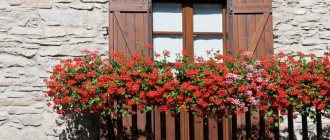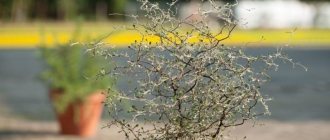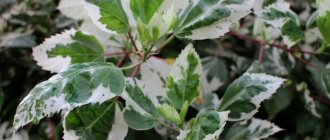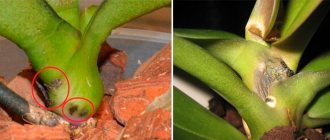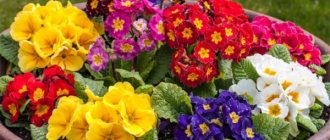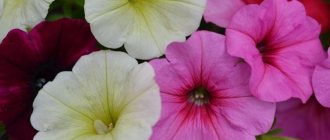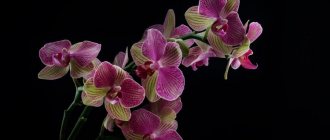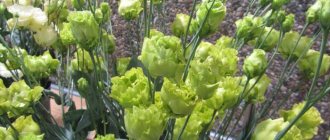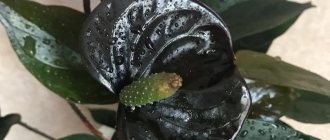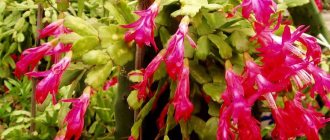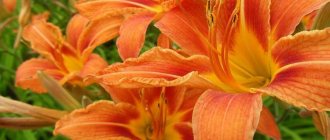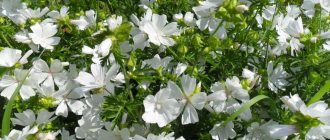How to define a group or class?
There are monopodial
Orchids with a vertical stem growing from a single apical growing point are classified as monopodial types.
They are characterized by the arrangement of juicy, fleshy leaves at the top of the stem, constantly increasing in length. The lower leaves age and droop as they grow, and the younger leaves alternately develop higher on the stem. Buds appear in the leaf axils, from which flower shoots, lateral shoots or aerial roots develop.
The monoploid type includes:
- Brassavola.
- phalaenopsis;
- Wanda;
- Angrecum;
Sympodial with pseudobulbs
Sympodial orchids resemble a climbing vine. Horizontal parts form rhizomes with internodes, vertical shoots form the above-ground part of the plant. Each shoot eventually stops growing in length, its apical bud dies, and new shoots and pseudobulbs appear at the base - above-ground thickenings formed in the internodes of the stem, which serve to store water and nutrients.
Pseudobulbs can be spherical, oval, elongated or flattened.
Sympodial species:
- Miltonia;
- Dendrobium;
- Cattleya;
- Oncidium.
Cascade or ampelous
Ampelous species are characterized by abundant flowering, long slender flower stems with abundant inflorescences and flowers located along the entire length of the flower stem:
- celogyne.
- grammatophyllum;
- dendrobium;
- cymbidium;
For indoor growing in a pot
Most types of orchids are suitable for growing at home. They differ from wild varieties in more lush vegetation and richly colored, large, thickened leaves:
- Cattleya;
- phalaenopsis;
- Miltonia;
- Cumbria.
Refers to street or garden
Garden orchids thrive in moderately warm climates; some hybrids are frost-resistant.
Curtains of low-growing herbaceous orchids in open ground are used in landscape design, but a single flower can decorate any flower bed:
- Tricyrtis.
- Cypripedium;
- Palchatocorynium;
- orchid;
Fragrant
Vanilla
The scent of orchids is designed to attract insects. Some plants have a very unpleasant amber scent, but most species emit spicy, honey, chocolate and fruity aromas. Some species emit scent only at certain times of the day, others only at the beginning of flowering.
Wild species have a strong odor, while domestic plants have a much weaker odor:
- zygopetalum;
- vanilla;
- arachnis;
- catazetum.
Midi, standard and mini
Among some species and hybrids of orchids, division into classes according to size is accepted:
- Mini - miniature orchids up to 20 cm high, with slender fifteen-centimeter flower stems, abundantly strewn with small flowers 3-5 cm in diameter.
- A standard orchid has a height of 60 to 80 centimeters, large flowers up to 15 centimeters in diameter and long pedicels up to 40 centimeters. Most orchids on sale come in a standard size.
- Midi is a compact plant up to 50 cm high. Flower stems reach a diameter of 30 cm, and flower buds - 6-8 cm.
You can read more about mini orchids here. In this article you will learn more about miniature phalaenopsis varieties.
Miniature varieties include:
- phalaenopsis;
- Cattleya;
- Dendrobium;
- Cymbidium;
- Oncidium.
With large and small flowers
Ludisia jewelica
The beauty of an orchid lies in its unusual colors. Large single flowers bloom only at the top of the peduncle; small spiral false inflorescences in the shape of bells or spikes often decorate the entire length of the peduncle.
Large-flowered orchids:
- Cymbidium.
- phalaenopsis;
- Cattleya;
- Cumbria;
Small-flowered varieties:
- rhynhostilis;
- Sidiraea japonica;
- Ludisia;
- orchid.
What does a bumblebee eat?
Clover is the favorite delicacy of bumblebees.
Perhaps these creatures are the most finicky of the bee order in terms of food. If wasps can eat jam, honey, tree sap and other sweets, then bumblebees have only pollen and nectar in their diet. However, the list of plants from which they collect food is very long. They pollinate almost all flowers that grow in their habitats. It is often used in gardening. If a beehive has appeared next to the garden, there is no doubt that in the near future there will be a large harvest in the garden beds.
The larvae also need food, so upon returning to the nest, individuals try to bring as much nectar as possible, which serves as food for future offspring. If necessary, the cubs are also fed home-produced honey.
The bumblebee's favorite flower is clover. He is attracted by the smell and color of the plant, and as he flies past he cannot resist. It has also been noticed that bumblebees, just like other bees, are more willing to sit on bright buds than on those that have faded colors. However, if there is no other vegetation nearby, the insect will not hesitate to land on them.
Geography of growth
The humid climate of the tropical and subtropical forests of Southeast Asia is most favorable for epiphytic plants. However, the ability of orchids to adapt to different living conditions is so great that they have spread throughout the world.
Botanists distinguish four zones in which orchids live:
- Temperate latitudes.
- Equatorial - South and Central America, African coast, Madagascar.
- Rocky Mountains - Southeast Asia, the mountains of Brazil and the Andes.
- Steppe.
Tropical Asian
Asian orchids are famous for their variety, which cannot be found in stores. Connoisseurs of rare plants order dendrobium, vanda, moccara, oncidium, phalaenopsis, among which miniature varieties are the most popular.
The biggest challenge in growing these plants is adapting to local conditions.
In the first days after transplantation, the flower requires a warm, bright place with high humidity, and only after a long rest can the plant be replanted.
Thai
There are more than 20 thousand species of orchids in Thailand. They grow on the trunks of street trees, in pots at the entrances to cafes and shops, and flirtatiously peer into the windows of houses. Stems of local varieties are the most popular souvenir among tourists, despite the fact that local law does not allow the export of orchids in pots.
The Thais have come up with an unusual way to export plants: in plastic or glass bottles with nutritional gel. Orchids cross the border of Thailand and, once transplanted, take root and are easy to care for at home.
Crimean
There are 45 species of orchids on the Crimean Peninsula:
- orchid;
- Comperia compera;;
- dremlik;
- Anacamptis;
- limodorum.
Siberian
For most people in Siberia, orchids are meaningless, but in this harsh climate there are about forty terrestrial species:
- Fingerroot.
- orchid breeding;
- orchid
- Buttercup;
- dreamlin;
Where does the bumblebee live?
Habitat of bumblebees
Due to their good adaptation to environmental conditions, bumblebees live in almost all corners of the planet. Exceptions are places where there is very little vegetation, as well as in hot climates. At high temperatures, the insect begins to feel uncomfortable due to the fact that its body already generates a lot of heat during activities.
In some places the number of bumblebees is small. For example, the Arctic Circle is home to small populations of individual species adapted to cold climates and capable of pollinating local vegetation. In Greenland, Alaska and Chukotka they can only be found in alpine meadows. Small populations also occur in lands with a tropical climate.
Interesting fact : in some countries, gardeners specially breed garden bumblebees to increase productivity.
Most species of bumblebees live in Russia, Europe, Asia and America. They enjoy the local climate and abundant vegetation. Not so long ago, insects were specially brought to Australia, to the state of Tasmania. There they are used to increase the yield of clover, and bumblebees cope with their task with five points. And their peacefulness simplifies the process of using them.
Interesting: Interesting facts about dragonflies, photos and videos
Alphabetical catalog of species: description of flowers and leaves
The catalog presents popular types of orchids with photographs, names and characteristics.
Ascocenda
Ascocenda is a hybrid of Vanda and Ascocentrum, a monoecious plant:
- Height from 30 to 60 cm;
- The roots are thick, covered with velamen;
- The leaves are striped;
- Flower stems up to 35 cm long, each with 12 to 25 large flowers;
- large, pansy-like flowers, 5-8 cm in diameter;
- Colors: dark yellow, purple, dark red, orange; A combination of two colors is possible.
Bifrenaria
Biphrenaria is a small epiphyllum with a pleasant aroma:
- colors - white, pink, yellow;
- Size from 30 to 50 cm;
- Flower stems are short, with one or two buds appearing at the base of the pseudobulbs;
- leaves are leathery, glossy, evenly green;
- the flowers are large, waxy, with a pale lip, collected in inflorescences;
- strong caramel aroma.
- Pseudobulbs are large, green-yellow, highly compressed, tetrahedral in shape;
Brassavola nodose
Brassavola nodosa is an epiphytic or lithophytic plant:
- size - from 35 to 50 cm;
- sympodial roots, but instead of them there are pseudobulbs, short, scaly, thick stems;
- leaves are simple, fleshy, dark green, one on each stem;
- flower stems are short (20 cm), erect, growing from the axils of the leaves;
- flowers up to 10 cm in diameter, from one to six on a peduncle, the petals are narrow, the lip is distinct, tubular at the base;
- colors: white, green, yellow;
- strong citrus aroma.
Brassia
Brassia are epiphytic orchids, attractive with unusually shaped flowers that, when fully open, resemble exotic spiders.
You can read more about this variety in the article: Brassia - an orchid with spider legs. All about types and care
Brassocattleya
Brassocattleya is a hybrid of Brassavola nodosa and Cattleya:
- The flowers are large, green, star-shaped, with a large lip with a fringed edge, white with purple spots.
- Height from 30 to 60 cm;
- The leaves are elongated, lanceolate (15 cm), growing singly from pseudobulbs;
- The roots are sympodial, the pseudobulbs are thin and long, like thick rhizomes;
- flower stems (15 cm) grow from the top of the pseudobulb; there are from 3 to 7 flowers on one flower stem;
Wanda
Vanda is a stunningly beautiful evergreen plant with 53 species varying in size, shape and color of brightly variegated flowers that can be white, blue, red, yellow, brown and shades. A distinctive feature of the Vanda genus is their grey-green, aerial roots.
Read here about the variety of varieties and colors of the vanda orchid.
Vanilla
Vanilla is a fast-growing, branched vine that attaches itself to trees at any height using its roots:
- up to 25 meters long;
- leaves are fleshy, leathery, oblong-lanceolate;
- aerial roots growing from internodes;
- Flower stems are numerous and short;
- the flowers are large, yellow-green, with an elongated lip;
- strong aroma.
Dendrobium
Dendrobium is a large genus of epiphytic orchids, including a large number of species and hybrid varieties, many of which are popular with gardeners.
All the necessary information on caring for this flower can be found in the article: Dendrobium Orchid: life cycle and care at home.
Zygopetalum
Zygopetalum has 16 different species of orchids. Characterized by abundant flowering:
- Brown, burgundy, dark green colors.
- The leaves are glossy green, elongated, pointed at the ends;
- Flower stems up to 50 cm long, containing from 9 to 12 buds;
- The roots are sympodial, oval, large pseudobulbs are arranged in a kind of ladder;
- a flower with lanceolate petals with sharp tips;
Cumbria
An artificially bred hybrid not found in nature. Developed by crossing several species of orchids, including Miltonia and Brassia. It develops in pseudobulbs, flower stems reach 60 centimeters in length. Popular colors: orange, white, brown, red with various spots.
You can read more about the Cumbrian orchid here.
Cattleya
Cattleya is a popular type of orchid with fragrant, large, bright flowers, solitary or collected in inflorescences. There are 187 species.
Lelia
Until recently, Laelia was confused with Cattleya due to its external similarity. There are 23 species, some of which became the ancestors of hybrid varieties:
- size - there are dwarf and large representatives;
- Leaves are lanceolate, dark green;
- The roots are sympodial, with fusiform, ovoid or cylindrical pseudobulbs;
- there are one or more flowers on the peduncle;
- the flowers are large, up to 20 cm in diameter, star-shaped, the petals are monochromatic, the lip is usually a different color;
- color white, pink, purple, yellow, cream;
- The aroma is pleasant, only smells during the day.
Lycasta
Lycaste is a genus of deciduous orchids, including about 40 main species and many hybrid varieties, including epiphytic and terrestrial varieties:
- Colors in shades of white, pink, light green, orange;
- leaves oblong or elliptical
- flower stems are numerous, long (up to 50 cm), each with one bud;
- the root system is sympodial with ovoid or pear-shaped pseudobulbs;
- strong aroma.
- The flower is large, up to 20 cm in diameter, with large sepals located at an angle of 120°, small petals are located close to each other and cover the style;
Ludisia precious
Ludisia is a small genus of orchids with small flowers and unusual large velvety leaves that are scarlet or light green on top with distinct veins.
Find out more about this variety in this article: Ludisia jewelica. Proper care of earthen orchid at home
Masdevallia
Masdevallia is a genus of miniature orchids with unusual flowers:
- The leaves are oblong-oval, grow vertically, singly on the stem;
- The roots are thin, creeping, without pseudobulbs;
- flower stems are short and erect;
- flowers of medium size, clearly triangular in shape, solitary or in inflorescences;
- color - the entire gamut of colors, with the exception of blue and shades of blue.
Masdevallias include one of the most unusual varieties of orchids - Dracula or monkey's face. Read here about all the rare varieties of orchids.
Miltonia
Miltonia is a genus of orchids with fragrant, panicle-like flowers that resemble eyes. There are 20 varieties and 40 hybrids of Miltonia.
Mix or hybrids
Hybrid varieties of orchids with different colors that are less demanding and bloom more profusely than the generic ones.
The most popular are phalaenopsis hybrids, but there are also hybrids of Cambria, Miltonia and Dendrobium.
Odontoglossum
Odontoglossum is a large subfamily with more than 200 species. The plant easily crosses with neighboring genera of the family, creating many hybrid varieties. It belongs to the orchids of temperate and cold-resistant climates. More information about Odontoglossum in this article.
Oncidium
Oncidium has about 700 species, many of which are very similar to Phalaenopsis. Oncidium is characterized by abundant and long-lasting flowering, the flowers look like dancing dolls, dressed in bright curls in shades of yellow, orange and brown with white frills.
Read more about this variety in the article: Oncidium or “dancing doll” orchid. 15 popular types
Paphiopedilum
Paphiopedilum is a large genus of terrestrial orchids that is called the "lady's slipper orchid" due to the characteristic shape of the large flower. Read here about popular Paphiopedilum varieties for growing at home.
Pleione formosana
Pleonias are deciduous, short-lived miniature shrubs. Pleione formosana - classic orchid:
- The flowers are white, light pink or yellow with a fringed lip and small spots.
- The leaves are oval, 10-12 cm long;
- roots of sympodial type with small, round pseudobulbs;
- The peduncle is short, with one large flower;
Promenea
Promenaea is a small genus of miniature epiphytic shrubs.
- The leaves are thin, light green with dark veins;
- The roots are weakly branched with flat pseudobulbs;
- Flower stems are short, 5-10 cm, with one or two small flowers;
- The flowers are pure yellow or yellow with burgundy spots, stripes and specks; resemble the open mouth of an animal.
Psychopsis
Psychopsis - recently separated into a separate genus, very similar to Oncidium:
- fluttering, butterfly-like flowers, reddish brown, cream, yellow, and spotted, bloom one after another, extending the bloom for many months.
- the leaves are oblong, dark green with small dark or light spots, two from each bulb;
- the roots are long, white with pear-shaped, small, dark green pseudobulbs;
- flower stem up to 120 cm long, with one, rarely two buds;
Sarcochilus
Sarcochilus is a monopodial, miniature species, easily cultivated:
- The leaves grow in pairs, are long, narrow, light to dark green with a deep central vein;
- the roots are long and numerous;
- flower stems are thin and long, containing from 4 to 30 buds;
- the flowers are small with a fleshy lip with a short spur;
- color white, pink, yellowish with numerous contrasting spots and lines;
- the aroma is pleasant and strong.
Phalaenopsis
Phalaenopsis is a genus of epiphytic orchids with unique speckled flowers. The color of the petals varies from snowy white to almost black. There are varieties in pink, yellow, purple and violet in varying intensities. It has a rich and pleasant aroma.
Read here about types of phalaenopsis, flowers and care.
Tselogina
Coelogyne is a large genus with about 120 varieties, many of which are suitable for hanging. Fragrant flowers of white, cream or yellow shades are arranged in tassels on long drooping stems.
Cymbidium
Cymbidium is an epiphytic evergreen orchid with highly fragrant flowers that range from white to cream, pink, red, caramel brown, soft green and bright yellow. It is distinguished by the characteristic boat-shaped lip of the flower.
You can read more about this variety in the article: Distinctive features of the cymbidium orchid. What types of flowers are suitable for growing at home?
Epidendrum
Epidendrum is a numerous genus of epiphytic plants of various sizes - from miniature (10 cm) to one and a half meter representatives, includes about 1,500 species of orchids, differing in the length of the stems, the shape of the leaves, the size and color of the flowers. Flowers are arranged in spherical, spike-shaped inflorescences.
Orchis or northern
Orchis maculata, known as the northern orchid, is a perennial herbaceous groundcover:
- The flowers are small, with a characteristic large pointed lip, numerous, collected in inflorescences;
- size from 10 to 60 cm, depending on the type;
- the roots are thickened in the form of two tubers, similar to kernels;
- the leaves are wide, fleshy, tightly wrapped around the stem, forming a petiole;
- from white to dark burgundy.
- Flower stems are tall with long (up to 20 cm) spike-shaped inflorescences at the top;
Social structure and reproduction
Bumblebee larvae
Like most bees, bumblebees have a clearly formed social structure. The insect lives in flocks, led by queens. At the beginning of spring they go in search of a male to produce offspring. After leaving the male, the female actively feeds so that the eggs are formed correctly.
After several weeks of abundant food intake, she begins to build a nest. Having done a lot of work, the queen settles in a new home, where she lays eggs. Usually there are around 15 of them at a time. They are oval in shape and no more than 4 mm. The larvae hatch on the seventh day after laying. For 20 days, the cubs eat pollen, after which they curl up into a cocoon. And after two and a half weeks, bumblebees are born. The hatched workers begin to engage in construction, and the queens continue to produce offspring.
Interesting fact : if there are not enough females in the flock to quickly increase the population size, they begin to be replaced by working individuals who are also capable of laying eggs.
This is how bumblebees live all year round, until frost sets in. The queens give birth to new offspring. Moreover, workers most often take care of the latter: they bring pollen to the larvae and protect them. The female is only required to lay eggs whenever possible.
Caring for them at home
Orchids need comfortable conditions for growth and long flowering:
- Air temperature 22-25 °C.
- Air humidity should be at least 70%.
- Scattered sunlight.
- Regular watering with pre-prepared water.
- Small pots with a diameter of 15-30 cm with a deep bottom.
- Substrate appropriate to the type of orchid: mixture of bark and peat moss for epiphytes, ready-made substrate for terrestrial orchids.
- Fertilize with special fertilizers during the growing season.
- Maintain a dormant period for flowering.
The orchid is an incredibly beautiful plant that is perfect for home growing, and a large number of species and hybrid varieties allows you to choose a plant to suit your taste.
Character traits
Bumblebees are friendly and peaceful animals.
Bumblebees live in small flocks. Often the total number of individuals does not exceed hundreds. They are divided into large queens, responsible for the production of offspring, into males, and into small worker insects. Despite the developed social structure, the individual is not attached to the nest and at a certain moment may not return to it and find a new home, joining another flock. Moreover, this is mainly done by males who have already helped females with the production of offspring.
Interesting: Bear
